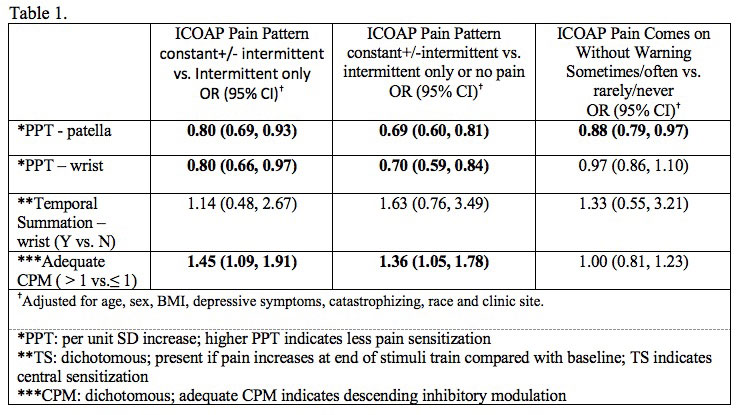Session Information
Date: Monday, November 11, 2019
Title: 4M115: Pain Mechanisms – Basic & Clinical Science (1878–1883)
Session Type: ACR Abstract Session
Session Time: 4:30PM-6:00PM
Background/Purpose: Intermittent pain progresses to constant pain in some, but not all, individuals with knee osteoarthritis (OA). Differing pain mechanisms may underlie these transitions. Later onset constant pain may represent pain sensitization or inadequate descending inhibitory modulation, while earlier intermittent pain may be due to peripherally-driven nociceptive input. We sought to examine the association of pain sensitization and conditioned pain modulation (CPM) to patterns and predictability of knee pain.
Methods: Subjects from the Multicenter Osteoarthritis (MOST) study, a NIH-funded longitudinal prospective cohort of older adults with or at risk of knee OA, at the 144-month visit were included in this cross-sectional analysis. Mechanical pressure pain threshold (PPT) at the wrist and patella were assessed with a handheld algometer. Lower PPTs indicate greater sensitization. Weighted mechanical punctate probes were used to assess temporal summation at the wrist, an indicator of central sensitization. Efficiency of CPM was determined by assessing PPT at the patella (test stimulus, PPT1) with forearm ischemia as the conditioning stimulus, followed by reassessment of PPT at the patella (PPT2). Adequate CPM is operationalized as PPT2:PPT1 >1. Knee pain patterns were defined using the Intermittent and Constant OA pain (ICOAP) scale as no intermittent or constant pain; intermittent pain only; constant pain only; or a mix of both. Unpredictable pain was assessed with a question regarding pain onset without warning. We evaluated the relation of pain sensitization and adequacy of CPM to pain patterns using logistic regression with general estimating equations to account for 2 knees within an individual. Analyses were adjusted for age, sex, BMI, race, clinic site, depressive symptoms and catastrophizing.
Results: There were 2817 subjects included (mean age 64 yrs, 57% female, mean BMI 29.4 kg/m2). Higher patellar PPT (less sensitivity) was associated with lower likelihood of constant +/- intermittent pain than intermittent only (OR 0.80 (95% CI 0.69, 0.93) or no pain (OR 0.69 (95% CI 0.60-0.81)) and less unpredictable pain (OR 0.88 (95% CI 0.79-0.97)) (Table). Similar findings were noted for wrist PPT, but were inverse for adequate CPM (Table). No associations were noted for temporal summation.
Conclusion: Lower levels of pain sensitization (by PPT) were associated with lower likelihood of constant +/- intermittent pain than intermittent pain or no pain, and less unpredictable pain. Adequate CPM was unexpectedly associated with greater likelihood of constant +/- intermittent pain, perhaps reflecting activation of this pathway when constant pain is present. These findings support the hypothesis that different pain mechanisms underlie intermittent vs. constant pain. Pain patterns noted over the course of OA appear to be related to peripheral +/- central facilitated ascending pain mechanisms.
To cite this abstract in AMA style:
Carlesso L, Frey Law L, Wang N, Nevitt M, Lewis B, Neogi T. The Relation of Pain Sensitization and Conditioned Pain Modulation to Pain Patterns in Knee Osteoarthritis: The Multicenter Osteoarthritis Study [abstract]. Arthritis Rheumatol. 2019; 71 (suppl 10). https://acrabstracts.org/abstract/the-relation-of-pain-sensitization-and-conditioned-pain-modulation-to-pain-patterns-in-knee-osteoarthritis-the-multicenter-osteoarthritis-study/. Accessed .« Back to 2019 ACR/ARP Annual Meeting
ACR Meeting Abstracts - https://acrabstracts.org/abstract/the-relation-of-pain-sensitization-and-conditioned-pain-modulation-to-pain-patterns-in-knee-osteoarthritis-the-multicenter-osteoarthritis-study/

